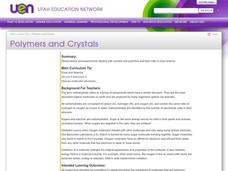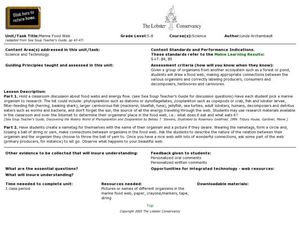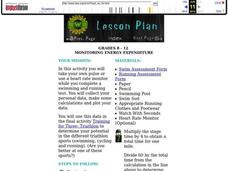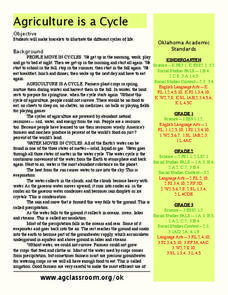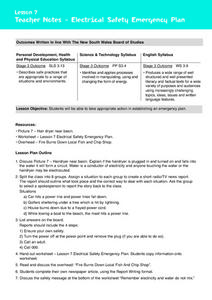Essential Energy
Being a Safety Star (Stage 3)
A spark of static electricity contains up to 3,000 volts, while a lightning strike contains around 3,000,000 volts. To understand electricity, its power, and the safety considerations relating to it learners engage in a comprehensive...
Curated OER
What is Energy?
Youngsters take a look at the foods they eat, and how they provide energy for them to do things. They look at how body uses the food energy to create movement. Pupils also look at toys/devices in the room that need electrical energy...
Curated OER
Polymers and Crystals: Their Role in Food Science
Blend chemistry with cooking in this exploration of polymers, carbohydrates, and food science. Experimenting with gelatin produces concrete examples of the bonding and ploymerization discussed in the lesson. Copious, comprehensive...
Baylor College
Energy for Life (Energy from Food)
Energy comes in many forms, but how do living things get the energy they need to survive and thrive? In a simple, controlled experiment with yeast, water, and sugar, groups make observations about how yeast reacts with water alone, then...
Curated OER
Grass as Biomass
Learners explore energy properties by listening to a sustainability lecture in class. In this biomass instructional activity, students identify what biomass is, how it can be transformed into a usable energy and how it complements the...
Curated OER
Transforming Food Energy: A Balancing Act
Pupils explain their role as consumers. They use a purchased calorimeter or make their own simple calorimeter to measure the energy content in selected foods. This interesting lesson really gets students thinking about what they eat.
Curated OER
Primary/Elementary Activity: Energy in Food
In this food energy worksheet, students rank the foods by the amount of energy they think the various food items have in them. Students then answer the 4 questions about food energy.
Baylor College
Food for Kids
Immediately capture the attention of your class with the smell of freshly popped popcorn in the sixth lesson of this series on the needs of living things. Young scientists first use their senses to make and record observations of...
Curated OER
Energy Balance: The Ins and Outs
Students review data from a 24-hour dietary recall to gain an understanding of the information regarding energy intake and macronutrients.
Baylor College
Digestion
Digestion is an amazing and complicated process that provides humans with the energy they need to survive. Lesson six in this series on the science of food uses sliced turkey and a meat tenderizer to demonstrate how enzymes help break...
Curated OER
Marine Food Web
Students investigate the effects of the food chain on all animals by creating a food web. In this seafood instructional activity, students discuss energy flow and research a specific marine organism of their choice. Students...
Curated OER
Monitoring Energy Expenditure
Young scholars use heart rate monitors and complete a swimming and running test. These tests allow students to obtain personal data, to manipulate the data through calculations of various parameters, and to graphically represent the data.
Curated OER
Breathing and Exercise
Students observe and record how breathing changes with physical activities. In this physical activity lesson students form groups and complete their activity and worksheets.
Curated OER
Rice Nutrition
Third graders investigate nutrition by researching rice. In this food lesson, 3rd graders read about the healthy aspects of rice and how many people in the world eat it. Students read nutrition labels and discuss the...
Curated OER
Chemistry of Food
For this chemistry of food worksheet, students complete 20 various types of questions related to food and nutrition. First, they complete a crossword puzzle with vocabulary terms. Then, students use the figure shown to write the...
Curated OER
Launching a Defense; Understanding the Human Immune System
Students research online to answer and develop questions about immune system, create Powerpoint presentation to share information with classmates, and assimilate information into pictorial and/or graphical description of immune system.
Curated OER
Launching a Defense; Understanding the Human Immune System
Students research online to answer and develop questions about immune system, create Powerpoint presentation to share information with classmates, and assimilate information into pictorial and/or graphical description of immune system.
Curated OER
The Human Organism
In this digestion and nutrition lesson, 3rd graders test foods to find their vitamin content. Students test for starch and fats then compare their findings on charts and oral reports. The lesson concludes with a teacher directed...
Curated OER
What's on Your Plate?
Students analyze the calorie content of food. In this health science instructional activity, students discuss how excess calories affect our body. They write a healthy meal plan for their family.
Curated OER
Agriculture is a Cycle
Students explore cycles in nature. For this cross curriculum agriculture lesson, students define "cycle" and research weather and planting folklore. Students make a bracelet in which individual colored beads represent the many "cycles"...
Pennsylvania Department of Education
The Digestive System
Fourth graders simulate how the digestive system works. In this hands-on simulation, 4th graders complete six group activities that help students visualize how our body breaks down food into nutrients.
Curated OER
Electrical Safety Emergency Plan
Students discuss Picture 7 which is a hairdryer near a basin. They discover that if the hairdryer is plugged in and turned on and falls into the water it will form a circuit and anyone touching the water or hairdryer may be electrocuted....
Curated OER
The Nutrients Public Transportation System
Students investigate the human circulatory system by experimenting with hoses. In this human body lesson, students create a system of hoses simulating the circulatory system which they utilize to pass objects through....
Curated OER
Training for Three: Triathlon
Students complete a final exercise test (cycle ergometer) that enable them to discuss their potential in each of the three events. They are introduced to the concepts of economy and efficiency in running, swimming and cycling.


